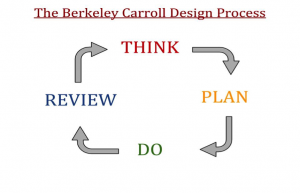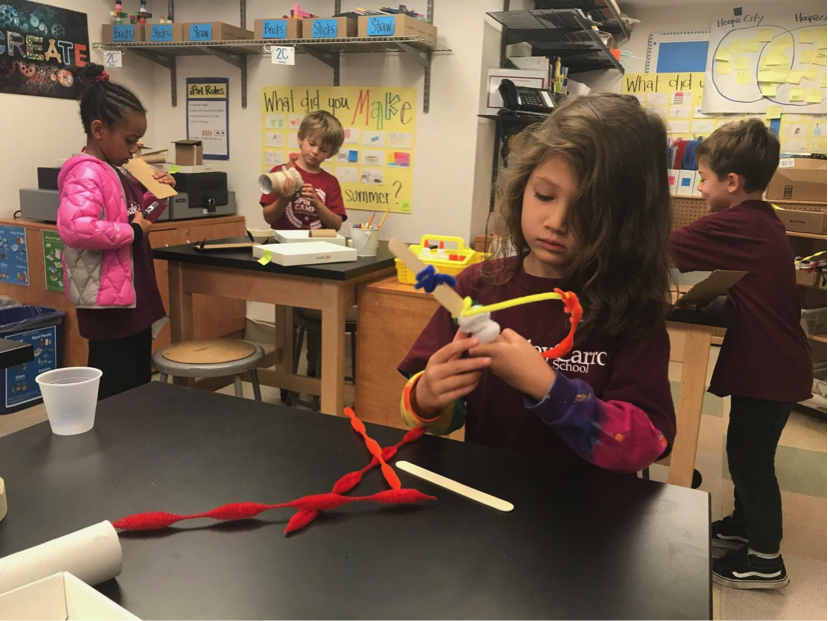Introduction to STEAM in Early Childhood
post by Camille Harrison
When I first jumped into a new role at my school as STEAM Integrator and Materials Librarian, the maker movement was in full swing. Makers are those who make, create, adapt and try to innovate in a variety of ways not limited to the more showy tech marvels so often highlighted on the pages of Make Magazine (https://makezine.com).
STEAM is an acronym that stands for science, technology, engineering, art, and math. It’s an evolution and in some cases an alternative to STEM, which doesn’t include art. I am most often asked why STEAM not STEM. For me, the addition of art doesn’t take away from the need or desire to highlight and encourage students to seek out the STEM fields. Rather the addition of art serves as an additional entry point for students who might not be inclined towards STEM topics. Moreover, I often encourage and challenge my students to see the many ways artists use principles of science, engineering, technology, and especially math in the things they create.
Although I don’t have dedicated class time with PreK and kindergarten students I do have time to collaborate with classroom teachers. What I have discovered is that by design most PreK units are innately STEAMy. For example, kindergarten students will be studying the Post Office in Social Studies which will spur the idea of creating a Postal Service for our school. From there dedicating time for students to create stamps, learn how to address envelopes and write letters, build post office boxes and then participate in picking up, sorting and delivering mail is what STEAM is all about.
First and second grade students have dedicated “STEAM” time as a special class once every six days in half groups for a 45-minute period (Note: Our school using a six-day cycle instead of a weekly calendar for classes.) In this class I focus on activities that introduce students to problem-solving in a hands-on way that most often connects to something they are studying in their classroom or in another special like science or art. Over the years we have developed a schoolwide design process that uses the language derived from our very own PreK classrooms: think, plan, do, review.

The Berkeley Carroll Design Process was developing with the goal to use language that would be familiar to students in PreK all the way to 12th grade.
In first grade students are first exposed to this through a problem I pose to them. My daughter loves bananas, so I often carry one with me in case she needs a quick snack. Bananas are great because you don’t need any utensils to eat them, and they are easy to carry because you don’t have to wash before you eat either. But the bad thing about bananas is that the can get bruised and mushy very quickly. From there I tell them about the first time I accidentally mushed a banana in my bag. I challenge them to help figure out a solution to my problem. From there they think about solutions and questions that they need more information about; draft a plan; build a prototype; and finally we test their creations.

First grade students working on their first prototype project. Students first learned about the problem, then brainstormed ideas and created a plan for their prototype. Materials they could use for their prototype include: toilet paper tubes, paper towel tubes, pipe cleaners, popsicle sticks, plastic cups and paper plates.
STEAM projects in early childhood can be as big as creating a schoolwide postal service to as small as giving students an opportunity to recreate something they learned about. What I have discovered is that the best projects are those that give students enough room to be creative, get messy, and connect to at least one concept they are learning in another subject.
very interesting
Exciting sounds like! My second grader has a stem class and excels in it more than other class! It’s something that grasp him,I know art and science is an important part of the learning process also! Great article.
As an Early Ed (Pre-School Teacher) I am elated with the idea of introducing these concepts to all. This is very much needed. I believe it to be very beneficial to all children Many of us simply did not know how to incorporate this into our daily curriculum.
I love the idea of specifically incorporating STEAM into my preschool class. We do all kinds of hands-on activities, but I’ll need to do some research to see what kinds of projects would focus on this type of concept in our classroom, especially with our 3 yr olds.
What was the solution to the banana dilemna?
There wasn’t just one solution. Some of the ideas students came up with were:
– To create a container that would hold the banana
– To create a removable pocket that I could attach to any bag so that the banana would have it’s own place to not get mushed
– To simply carry the banana at the top of the bag
Once they built their prototype I had them test it with bananas that ultimately became banana bread. We have a lot of mushing happening! Here’s the Banana Saver that I actually use to carry bananas in my back: https://www.amazon.com/Peregrine-609230-PEREGRINE-Banana-Yellow/dp/B002A8HSXW.
Wow! thanks for this very important information. I’m currently working with 4-5 year olds. I had no idea that STEAM could apply to the early ages. thanks for sharing. Do you know of any helpful websites or resources that I could use in my classroom?
First time reading about this ad its very informative.
As a preschool teacher I have children that will pic art over any other interest center. A reminder of how art can be included in stem will make a better classroom.